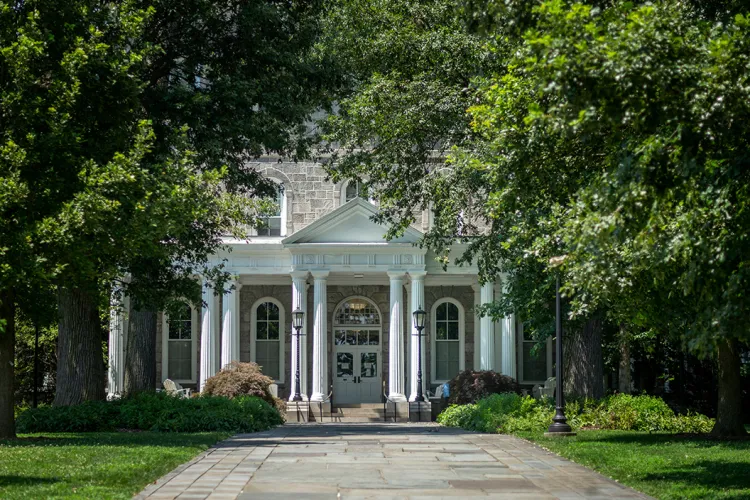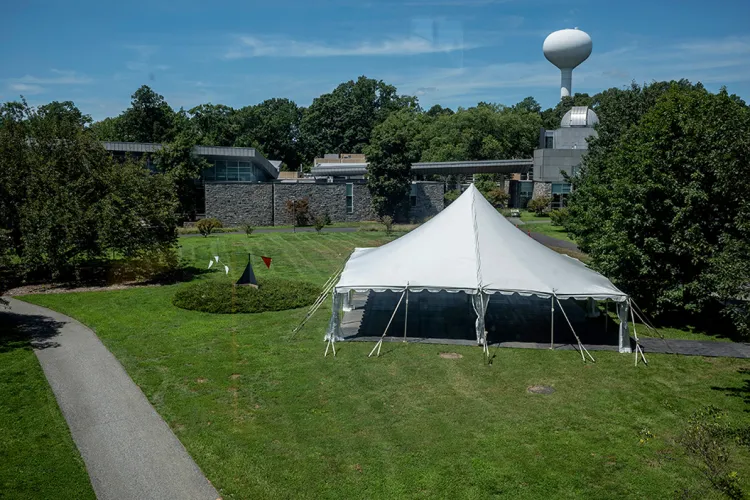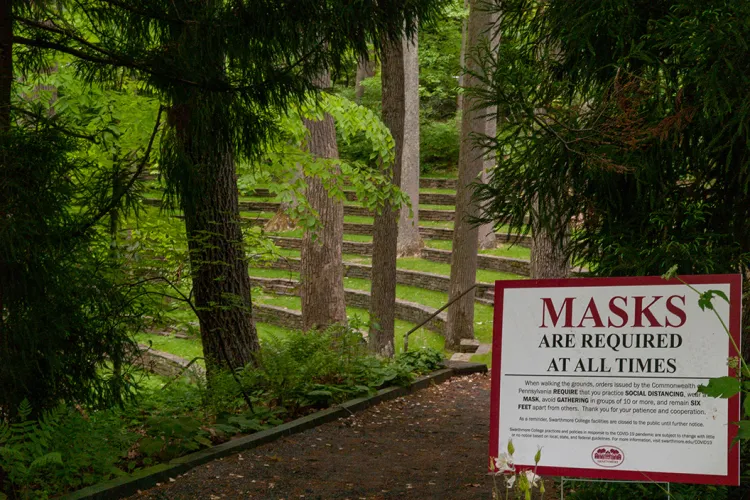College Community Rises to Challenge of Preparing for Year of Uncertainty

The upcoming academic year at Swarthmore “will be unlike anything we have ever experienced,” says President Valerie Smith.
“It will demand great flexibility and adaptability from all of us, since we cannot predict the ways in which [the COVID-19 pandemic] will continue to disrupt our lives and our work,” Smith added in a recent information session for faculty and staff. “But despite the uncertainty that lies ahead, we will always work to protect the health and safety of our students, faculty, staff, and members of the surrounding community.”
It’s an enormous challenge, but community members from across Swarthmore — including those in facilities, the Office Of Student Engagement (OSE), and student health — have risen to meet it. From requiring COVID-19 testing of all students, faculty, and staff members on campus, to modifying and maximizing classroom and common spaces, to enhancing student life and ensuring student wellness, the College has worked tirelessly to anticipate the multitude of preparations needed to navigate the coming months.
The following are snapshots of some of the safety measures and preparations from across campus.
Mitigating the Threat of COVID-19
“This is going to be a different year and experience for students, for so many reasons,” Jim Terhune, vice president for student affairs, said in the faculty and staff information session.
The moment students arrive, they will be tested for COVID-19 with a low-nose swab. They will be retested a week later, and then a week after that, to cover the incubation period for the virus.
Meanwhile, the College “will be focused on educating students and the community as a whole on universal mitigation policy,” says Casey Anderson, director of student health and wellness.
A key component of that is the Garnet Pledge, developed by students, staff, and faculty, which must be signed by students in order to live on campus. This commitment to the common good outlines requirements such as the wearing of masks, physical distancing, limiting trips beyond campus, and more.
Staff and faculty were asked to sign a similar pledge, and those working regularly on campus will be tested for COVID-19 weekly. Those who will visit campus only occasionally will be tested 72 hours prior to their arrival.
When community members are first tested, they will receive a safety kit that includes a cloth mask, a disposable mask, hand sanitizer and spray, and a tool for opening doors without touching them. Additionally, Environmental Services has placed sanitation kits around campus for people to sanitize offices and common spaces.
Students who test positive for the virus will be moved to isolation housing, and those who come into close contact with someone who tests positive will be moved to quarantine housing. Quarantine housing will also be used for students who have symptoms of the virus and are awaiting test results. In each scenario, students will have access to medical care, counseling, delivery of meals, and more.
The College will also administer contact tracing to ensure the health of the Swarthmore community, while maintaining the confidentiality of individuals.

Three large tents, complete with power, lighting, Wi-Fi, and projection capabilities, have been erected to accommodate outdoor classes.
Maximizing the Function and Safety of Campus Spaces
The Facilities Management staff has worked extensively to ensure all campus spaces are as safe and useful as they can be, says Andy Feick, vice president for sustainable operation and capital planning. Feick is confident that the thorough guidelines of the department’s COVID-safety working group have been met.
“I am very proud of the way everyone is pulling together for this cause,” Feick says.
The first thing community members might notice are the three large tents on campus erected to accommodate outdoor classes. These are equipped with power, lighting, and — thanks to the efforts of Information Technology Services (ITS) — Wi-Fi.
There are also 6-by-6-foot squares on Parrish Beach and various quads across campus, so that students can socialize with one another while maintaining physical distancing. These figure to be popular spaces for the first 14 days of the semester, during which Sharples Dining Hall will only offer meals to go.
Facilities Management also assessed every interior space on campus in which people gather, to determine new occupancy limits and promote physical distancing. This effort entailed removing furniture from certain classrooms and common spaces, marking floors for chair placement and one-way foot traffic, and installing partitions for classroom instruction.
Additional steps taken by Facilities Management:
- Placing signage all across campus advising on safety guidelines, and stressing that the campus is closed to the public effective Aug. 31.
- Upgrading air filters in buildings to meet COVID-19 recommendations, and increasing the number of air exchanges.
- Setting systems to more regularly purge air from buildings, continuing for an hour after they close and resuming an hour before they reopen.
- Installing at least one water bottle-filling station per building, and disabling the traditional fountains.
- Preparing all residence hall rooms for move-in day, which included packing and shipping many students’ belongings left behind in the spring.
- Cleaning buildings and high-touch areas like stairs and elevators twice a day, every day.
- Ensuring there are hand-sanitizer stations in all buildings.
- Modifying restrooms to allow hands-free handwashing and exiting.
- Collaborating with staff from the Libraries and the Athletics Department to modify spaces to promote physical distancing.
- Collaborating with ITS to confirm that the technology of every space is in working order and that tech support will be available.
Enhancing the Student Experience
The College invited first-year students, sophomores, new transfer students, and resident assistants to live on campus this fall, as well as international students and students for whom working remotely would not be feasible. Approximately 670 students opted to do so, with about 775 students planning to learn remotely.
On behalf of students on campus, the OSE spent the summer developing strategies to “put health, safety, and community above all else,” says Rachel Head, associate dean and director of student engagement. Students will notice this right away through the contactless move-in process and changes to their living spaces (including all rooms being singles) to ensure physical distancing.
But OSE was intentional about considering the experience of students off campus, as well, and of ways to engage them.
“Whether they are sitting in their dorm room in Willets, dialing in from an apartment in California, or connecting from their living room in New Zealand, we are working hard to help ensure that all students can participate in virtual activities like the Friday-night talent show, assorted movie screenings, and even a remote student activities fair,” Head says. “We will work to ensure that students who are not on campus are connected with others, supported in their interests, and know that they are important members of the Swarthmore family.”
Among other steps undertaken by OSE:
- Creating a cohort of remote resident assistants (RAs) to work with off-campus students.
- Reducing the population within residence halls to support an average of one bathroom fixture per 3.5 students.
- Restricting access to some facilities to residential students.
- Limiting access to residential space to only their residents.
- Establishing a reservation system for laundry, available via OneCard.

Signs placed all around campus remind community members to observe physical distancing guidelines to maintain the health and safety of themselves and others.
Ensuring Student Health and Wellness
Always a key component of the College, the Worth Health Center has played a central role in preparing for this year’s unique circumstances.
“The health center staff is committed to providing students with both acute and chronic health care, and maintaining the health and safety of our community as we navigate our way through this pandemic,” says Anderson, the director of student health and wellness.
The staff has implemented mobile check-in for appointments, so students can use their personal devices instead of touching the waiting-room computer. Additionally, all students and health center staff will have their temperatures checked before they enter the building.
The health center is also limiting contact between individuals during appointments, and has set up separate exam rooms and equipment for sick and well office visits. The staff has developed specific health and wellness plans related to COVID-19, as well, for students who need support during an illness.
Among the other aspects of the health center’s plan:
- Using the video-conferencing tool Zoom for Healthcare as much as possible.
- Requiring students to call and speak with a nurse prior to coming to the health center; no walk-ins are permitted.
- Staggering in-person appointments to keep the waiting room as empty as possible.
- Having staff use screening tools for students’ daily symptoms, and following up as needed.
- Coordinating with Public Safety on new protocols related to COVID-19, including medical transports.



